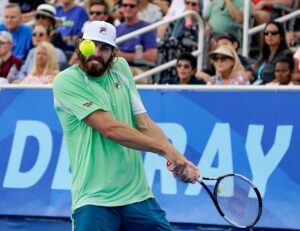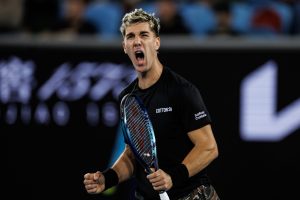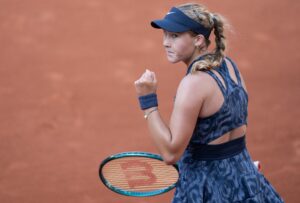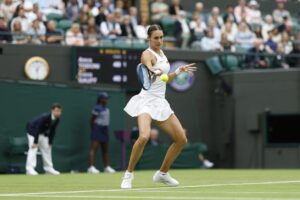Nadal-Kyrgios has all the makings of a classic tennis feud, or at least the beginnings of one. Rafael Nadal’s furious reaction to Nick Kyrgios serving under-arm at the end of their match in the Mexican Open this week, saying that the young Australian “lacks respect for the public, the rival and himself”, was met almost instantaneously by Kyrgios’s response on Instagram: “I can smell the blood when I play this dude”. Suffice to say that it will be fascinating to watch the next match between the two men.
Nevertheless, Nadal-Kyrgios still has a way to go before it can match the intensity and enduring nature of these classic confrontations, when two players duelled with each other, on and off the court.
Here are five famous (or infamous) tennis feuds.
- Eugenie BOUCHARD-Maria SHARAPOVA
In many ways, Eugenie Bouchard should have been Maria Sharapova’s heiress apparent as probably the most photogenic (and therefore the most marketable) woman on the WTA Tour, and so could have looked to the older Russian player for advice on how to make millions from sponsorship, advertising and fashion, let alone through her on-court efforts. But that will never happen now, not after Bouchard publicly called Sharapova a “cheater” when she returned to the tour after her 15-month ban for taking meldonium, a banned substance.
Many players, both male and female, privately expressed their dissatisfaction with Sharapova returning to the court so soon, especially after her initial two-year ban was nearly halved on appeal. However, Bouchard went public with her condemnation (some would say with complete justification). When pressed on her remarks about Sharapova, Bouchard not only refused to recant but further claimed that her fellow players were supportive of her.
Sharapova, for all her faults (not least taking banned substances), would never have got to the top of tennis and achieved a Career Grand Slam without being able to return serve, or anything else fired at her. Consequently, when she lost to Bouchard at the Madrid Open in 2017, when she was only just resuming her career after the drugs ban, she immediately “liked” a photoshopped image of a Bouchard autobiography, entitled, “Insufferable: My Life So Far”, in an obvious reference to her own autobiography, which had been modestly called, “Unstoppable: My Life So Far”.
The irony is, of course, that both women have been anything but “Unstoppable” in recent years, as Sharapova has still failed to regain her best form nearly two years after returning to the tour, while Bouchard’s decline, which began with her fall on a slippery locker-room floor at the 2015 US Open, has been even more dramatic. In effect, both women have suffered an “Insufferable” past few years.
- Bernard TOMIC-Lleyton HEWITT
If “mateship” is the Australian term that best expresses the delight of men, particularly members of the same sporting team, at being in their own company and struggling collectively to win something, then perhaps “hateship” is the term that best describes the increasingly toxic relationship between two of the country’s best tennis players of the 21st century, Bernard Tomic and Lleyton Hewitt.
That toxicity reached a new high (or low, depending on how you look at it) at the Australian Open this year, when Hewitt, two-time Major winner and Australia’s current Davis Cup Captain, publicly accused his much younger (and, so far at least, much less successful) compatriot of threatening him “physically” and claimed that Tomic had even attempted to “blackmail” him into selecting him for the Davis Cup. In the best traditions of Australia’s terrier-like tennis players, of which Hewitt is a prime example, Tomic immediately hit back, claiming that Hewitt was a “liar” for making such claims, and was also biased towards certain other Australian players, such as rising star Alex de Minaur, partly because they were represented by Hewitt’s management company.
By the end of the 2019 Australian Open, Hewitt was claiming that it was “highly unlikely” that Tomic would ever play for Australia again in the Davis Cup, at least while he was Captain of the side, to which Tomic responded by saying that Hewitt was ruining Australia’s chances of ever winning the Davis Cup again by failing to select the best available players.
Whoever is ultimately to blame (and, as in most arguments, blame is likely to be apportioned between both parties), what is undeniable is that the mutual resentment, if not hatred, of Tomic and Hewitt has weakened Australia’s chances at this year’s revamped Davis Cup. With a fully focused and motivated Tomic alongside the likes of de Minaur and Nick Kyrgios (assuming Kyrgios decides to play in Madrid in November and risk the wrath of Rafa Nadal’s fellow Spaniards), Australia would have had a realistic chance of winning the Davis Cup for the first time since 2003, when Hewitt himself was playing. Without Tomic, those chances are significantly reduced.
- John MCENROE-Ivan LENDL
It says everything about John McEnroe’s sheer combativeness as a player that he appears twice on this list. And the first of his two great feuds was with the man who was in so many ways his polar opposite, Ivan Lendl.
Lendl emerged from Czechoslovakia in the early 1980s to fill the Borg-shaped hole that Bjorn Borg’s shockingly early retirement (when he was only 26 and still in apparently peak physical condition) had left, both on the ATP Tour in general and in particular in McEnroe’s career. Ironically, for all their apparent “fire and ice” differences, McEnroe and Borg had always got along well personally, to the extent that McEnroe not only tried to talk Borg out of retiring but always claimed afterwards that he, too, had lost something vital when the great Swede stopped playing.
With Lendl, however, there was none of that personal connectivity. Indeed, at the height of the Cold War, McEnroe and Lendl seemed to represent a two-man Cold War, with the Eastern European remaining calm and impassive on court (which apparently was completely at odds with his off-court persona, as the likes of Andy Murray have testified) while McEnroe so often raged, both against his opponent and himself.
In the end, perhaps, McEnroe’s fire or rage burned itself out. Having initially dominated Lendl on court, he famously lost the 1984 French Open Final from being two sets up, having played arguably the best tennis of his career, and although he gained revenge by defeating Lendl again in the US Open Final later that year, he never won another Major after that. By contrast, Lendl went on to dominate tennis in the second half of the 1980s, eventually winning eight Grand Slam Singles titles to McEnroe’s seven.
- John McENROE-Jimmy CONNORS
In the 1980s, John McEnroe obviously had a lot of dislike, if not actual hatred, to go round, as he feuded not only with Ivan Lendl but with his fellow American, Jimmy Connors. If the rivalry between McEnroe and Lendl had been one of apparent opposites – the fiery American serve-and-volleyer versus the dour Czech baseliner – the problem between McEnroe and Connors may simply have been that they were too alike.
Both McEnroe and Connors were ultra-aggressive players, at a time when tennis (which had only become a fully professional sport in 1968) was still trying to shed its image of being ultra-genteel; both men had been coached, or at least largely inspired to play the game in the first place, by one of their parents (in McEnroe’s case, by his father, while Connors was coached by his mother); and of course, as compatriots, both men were fighting to be not only the best player in the world but the best player in their home country. And as the playwright David Mamet famously said of writerly rivalries, “Everyone wants to be the only Romanian in the room”.
If the McEnroe-Lendl rivalry was largely confined to the court, the McEnroe-Connors rivalry often extended beyond it, with McEnroe claiming in at least one post-retirement interview that Connors was “a complete ass-hole”. (He claimed afterwards to be only joking, but it seemed to be a joke that revealed a lot of genuine personal feeling.) Similarly, in a match between the two men in Chicago in 1982, Connors crossed the line, as it were, by crossing over to the other side of the court to angrily wag his finger in McEnroe’s face, in protest at what he perceived to be disrespectful behaviour by the younger man.
Their greatest on-court battles were reserved for Wimbledon in the early 1980s, and in particular the Men’s Singles Finals of 1982 and 1984. In the first, Connors defeated McEnroe in a five-set classic. In the second, McEnroe effectively wiped the floor (or at least the grass) with Connors, defeating him in straight sets, for the loss of only four games in total, in the process playing serve-and-volley tennis that was so sublime that Connors, sticking to the baseline as usual, became a virtual bystander.
- Martina NAVRATILOVA-Margaret COURT
The most famous (or infamous) feud in the history of tennis, and arguably the most important because of what it signifies about both the sport itself and society in general, is that between Margaret Court and Martina Navratilova, two women who are undoubtedly in the top three female tennis players of all time. (Serena Williams is the third member of that “holy trinity”.) And yet that rivalry is not really based on their matches against each other but on their off-court rivalry, which one might well describe as a “culture war”, or at least a cultural battle.
The playing careers of Navratilova and Court did not really overlap, as the great Australian (who is still the record-holder, with 24 titles, for most Women’s Singles Major wins) was coming to the end of her career just as Navratilova was beginning hers. They met four times on court in the mid-1970s, with Court winning their first encounter (in the 1975 Wimbledon quarterfinals) and Navratilova winning the other three.
It is only in recent years, long after Navratilova herself had retired from playing tennis, that their rivalry has achieved epic (as in epically awful) proportions. That is because the two women could not be more different off court. After retiring from playing, Margaret Court became an evangelical Christian preacher, a firebrand who has consistently denounced homosexual relationships as un-Christian, if not actually evil, and actively opposed same-sex marriage. By complete contrast, Navratilova is openly gay, having married Julia Lemigova, a Russian businesswoman, and has consistently campaigned for gay and lesbian rights, both in America and around the world.
The completely opposed world-views of Navratilova and Court have come to a head, and become intensely personal, at the Australian Open in recent years, where Navratilova has joined the growing calls for the “Margaret Court Arena” to be renamed because of the reactionary views of the woman it is named after, while Court herself has not deviated in the slightest from her fundamentalist views.
Ironically, therefore, Court may just have enjoyed Navratilova’s recent travails, as a prominent American LGBT organisation, Athelete Ally, severed its links with her for what they regarded as her “transphobic” comments about transgender athletes. It is a reminder that in feuds, sporting or otherwise, usually both sides lose.
Main Photo:






